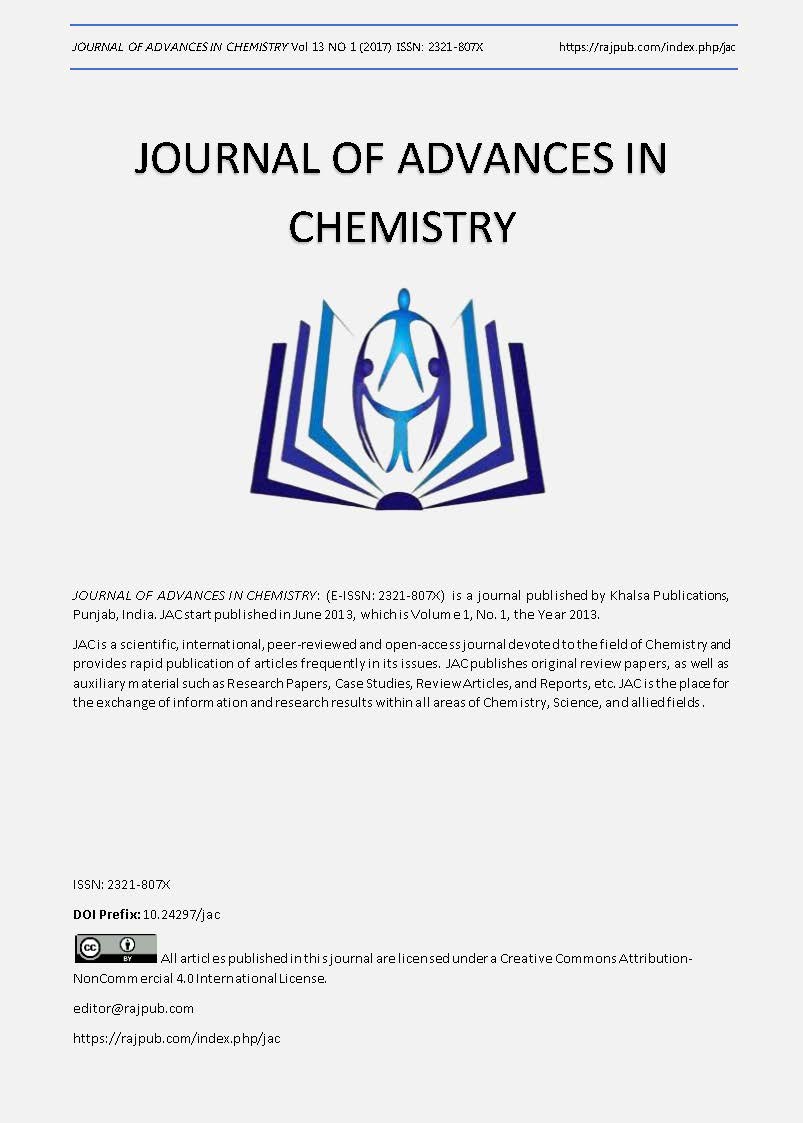Computational study of the chemical reactivity properties of bis (trimethyl tetrathiafulvalenyl) thiophene
DOI:
https://doi.org/10.24297/jac.v13i12.6072Keywords:
Tetrathiafulvalenes, density functional theory, computational chemistry, quantum chemical calculationsAbstract
The chemical reactivity of four bis (trimethyltetrathiafulvalenyl) thiophene is determined by its potential (electronic) energy (hyper) surface. All the quantum chemical calculations have been carried out using DFT level of theory, B3LYP functional and 6-31G(d,p) as basis set. Molecular electrostatic potential (MEP) and HOMO-LUMO energy levels have been performed. The local reactivity descriptor such as Fukui function is also performed to determine the reactive sites within the title molecules. The chemometric methods PCA and HCA were employed to find the subset of variables that could correctly classify the compounds according to their reactivity.
Downloads
References
[2] W. Kohn, Nobel Lecture: Electronic structure of matter-wave functions and density functionals. Rev. Mod. Phys. 71, 1253-1266 (1999).
[3] W. Kohn, L.J. Sham, Self-Consistent Equations Including Exchange and Correlation Effects. Phys. Rev. 140, 1133-1138 (1965).
[4] R.G. Par, W Yang, Functional theory of atoms and molecules, (1st ed) Oxford: University Press: New York, 1989.
[5] J.L. Gázquez, Perspectives on the Density Functional Theory of Chemical Reactivity. J. Mex. Chem. Soc. 52, 3-10 (2008).
[6] P. Geerlings, F. De Proft, W. Langenaeker, Conceptual Density Functional Theory. Chem. Rev. 103, 1793-1874 (2003).
[7] M.J. Frisch, G.W. Trucks, H.B. Schlegel, G.E. Scuseria, M.A. Robb, J.R. Cheeseman, G. Scalmani, V. Barone, B. Mennucci, G.A. Petersson, Gaussian 09, Revision C.01; Gaussian Inc. Wallingford, CT, USA, 2010.
[8] H.B. Schlegel, Optimization of Equilibrium Geometries and Transition Structures. J. Comput. Chem. 3, 214-218 (1982).
[9] R. Ditchfield, W.J. Hehre, J.A. Pople, Selfâ€Consistent Molecularâ€Orbital Methods. IX. An Extended Gaussianâ€Type Basis for Molecularâ€Orbital Studies of Organic Molecules. J. Chem. Phys. 54, 724-728 (1971).
[10] R. Dennington, T. Keith, J. Millam, GaussView, Version 5, Semichem Inc. Shawnee Mission, KS, 2009.
[11] A.D. Becke, Density-functional thermochemistry. III. The role of exact exchange. J. Chem. Phys. 98, 5648 -5652 (1993).
[12] T. Koopmans, Ordering of wave functions and eigenenergies to the individual electrons of an ato. Physica. 1, 104-113 (1993).
[13] T. Abbaz, A.K Gouasmia, H. Fujiwara, T. Hiraoka, T. Sugimoto, M. Taillefer, J.M. Fabre, New TTF and bis-TTF containing thiophene units: Electrical properties of the resulting salts. Synthetic Metals. 157, 508-516 (2007).
[14] S. Bouguessa, A.K Gouasmia, S. Golhen, L. Ouahab, J.M. Fabre, Synthesis and characterization of TTF-type precursors for the construction of conducting and magnetic molecular materials. Tetrahedron Lett. 44, 9275-9278 (2003).
[15] A.J. Moore, M.R. Bryce, A.S. Batsanov, J.C. Cole, A.K. Howard, functionalized Trimethyltetrathiafulvalene (TriMe-TTF) Derivatives via Reactions of Trimethyltetrathiafulvalenyllithium with Electrophiles: X-ray Crystal Structures of Benzoyl-TriMe-TTF and Benzoylthio-TriMe-TTF. Synthesis. 6, 675-682 (1995).
[16] P. Politzer, J.S. Murray, The fundamental nature and role of the electrostatic potential in atoms and molecules. Theor. Chem. Acc. 108, 134-142 (2002).
[17] R.G. Parr, R.G. Pearson, Absolute hardness: companion parameter to absolute electronegativity. J. Am. Chem. Soc. 105, 7512-7516 (1983).
[18] J.P. Perdew, R.G. Parr, M. Levy, J.L. Baldu, Density-Functional Theory for Fractional Particle Number: Derivative Discontinuities of the Energy. Phys. Rev. Lett. 49, 1691-1694 (1982).
[19] Y. Zhang, W. Yang, Perspective on “Density-functional theory for fractional particle number: derivative discontinuities of the energyâ€. Theory. Chem. Acc. 103, 346-348 (2000).
[20] P.W. Ayers, The dependence on and continuity of the energy and other molecular properties with respect to the number of electrons. Math. Chem. 43, 285-303 (2008).
[21] R.G. Pearson, Chemical hardness: Applications from molecules to Solids, VCH-Wiley: Weinheim, Germany, 1997.
[22] R.G. Pearson, The principle of maximum hardness. Acc. Chem. Res. 26, 250-255 (1993).
[23] R.G. Parr, P.K. Chattaraj, Principle of maximum hardness. J. Am. Chem. Soc. 113, 1854-1855 (1991).
[24] P.K. Chattaraj, J.R. Hammond, Reappraisal of cis effect in 1,2-dihaloethenes: An improved virtual orbital multireference approach. J. Chem. Phys. 129, 064101-064109 (2008).
[25] R.P. Iczkowski, J.L. Margrave, Electronegativity. J. Am. Chem. Soc. 83, 3547-3551 (1961).
[26] T.K. Ghanty, S.K. Ghosh, Correlation between hardness, polarizability, and size of atoms, molecules, and clusters. J. Phys. Chem. 97, 4951-4953 (1993).
[27] R. Roy, A.K. Chandra, S. Pal, Correlation of polarizability, hardness and electronegativity: polyatomic molecules. J. Phys. Chem. 98, 10447-10450 (1994).
[28] Y. Simon-Manso, P. Fuentealba. On the Density Functional Relationship between Static Dipole Polarizability and Global Softness. J. Phys. Chem. A. 102, 2029-2032 (1998).
[29] P.W. Ayers, The physical basis of the hard/soft acid/base principle. Faraday Discuss. 135, 161-190 (2007).
[30] R.G. Parr, W. Yang, Density functional approach to the frontier-electron theory of chemical reactivity. J. Am. Chem. Soc. 106, 4049-4050 (1984).
[31] W. Yang, R.G. Parr, Hardness, softness, and the fukui function in the electronic theory of metals and catalysis. Proc. Natl. Acad. Sci. 82, 6723-6726 (1985).
[32] M. Berkowitz, Density functional approach to frontier controlled reactions. J. Am. Chem. Soc. 109, 4823-4825 (1987).
[33] W. Yang, W.J. Mortier, The use of global and local molecular parameters for the analysis of the gas-phase basicity of amines. J. Am. Chem. Soc. 108, 5708-5711 (1936).
Downloads
Published
How to Cite
Issue
Section
License
 All articles published in Journal of Advances in Linguistics are licensed under a Creative Commons Attribution 4.0 International License.
All articles published in Journal of Advances in Linguistics are licensed under a Creative Commons Attribution 4.0 International License.




